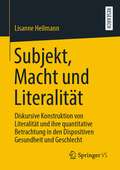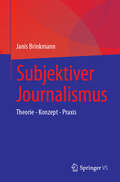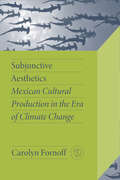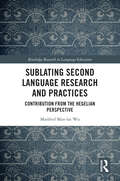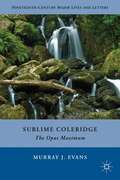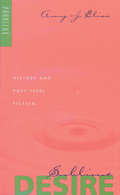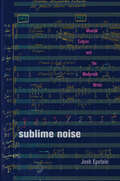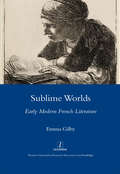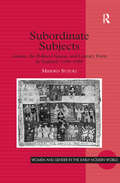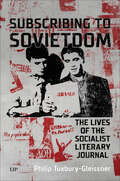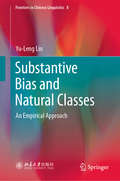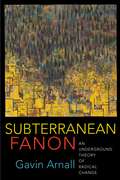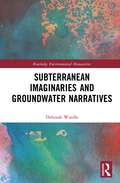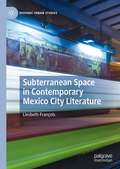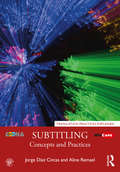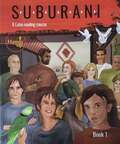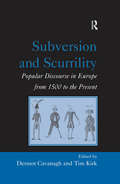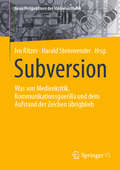- Table View
- List View
Subjekt, Macht und Literalität: Diskursive Konstruktion von Literalität und ihre quantitative Betrachtung in den Dispositiven Gesundheit und Geschlecht
by Lisanne Heilmann(Literale) Kompetenzen können – aus einer poststrukturalistischen Perspektive – nicht beobachtet, sondern nur zugeschrieben werden. Diese Zuschreibungen finden in diskursiven Anrufungen statt, in denen Individuen als kompetente oder inkompetente und als hoch oder gering literalisierte Subjekte adressiert und konstruiert werden. Lisanne Heilmann untersucht im vorliegenden Buch diese Zuschreibungen hinsichtlich ihrer komplexen Einbettung in (foucaultsche) Machtverhältnisse und die darin vorgenommenen Anrufungen und Formungen von literalen und literalisierten Subjekten. Aufbauend auf Foucault, Butler und die New Literacy Studies werden hier Literalitätsdiskurse in ihren komplexen Machtstrukturen und ambivalenten Subjektformungen analysiert und die Möglichkeiten quantitativer Forschung vor diesem Hintergrund erörtert. Die Autorin Lisanne Heilmann forscht insbesondere zu Fragen der Konstruktion von Grundkompetenz im Kontext von Geschlecht, Mehrsprachigkeit, Migration und Gesundheit. Sie ist die Koordinator*in des Projektes „Alltagsmathematik als Teil der Grundbildung Erwachsener (Hamburg Numeracy Project)“ und wissenschaftliche Mitarbeiter*in in der Studie „LEO 2018 – Leben mit geringer Literalität“.
Subjektiver Journalismus: Theorie - Konzept - Praxis
by Janis BrinkmannJournalismus wandelt sich – und bringt zunehmend neue Formen und Formate hervor, die u.a. investigative, narrative, interpretative oder partizipative Muster, Mechanismen und Merkmale des Journalismus integrieren und neu arrangieren. Doch wie sich ein teils explizit subjektiver und meinungsbasierter „Neuer Journalismus“ entwickelt und in der Praxis an Einfluss gewinnt, ist angesichts der oft fluiden Forschungsgegenstände in der Journalistik bislang nicht erforscht. Die vorliegende Studie, die am Institut für Journalistik an der Fakultät Kulturwissenschaften der Technischen Universität Dortmund als Habilitationsschrift eingereicht wurde, widmet sich daher Programmen, Praktiken und Leistungspotenzialen eines subjektiven Journalismus, wie er sich gegenwärtig in Formen des Social Journalism vollzieht (z.B. bei funk, Vice, BuzzFeed), der über soziale Medien jüngere Zielgruppen adressiert und sich radikal an deren Thematisierungs-, Präsentations-, Nutzungs- und Rezeptionserwartungen orientiert.Vor einer konstruktivistisch geprägten Hintergrundfolie wird zunächst ein integrativ-intergrativer Theorierahmen aufgespannt, der strukturell-individualistische mit figurations-analytischen und praxistheoretischen Bausteinen verknüpft, um die Konstruktionsprogramme, Praxiskonstellationen und Leistungspotenziale von Formen des subjektiven Journalismus zu rekonstruieren, zu analysieren und zu bewerten. Dafür wird ein triangulatives Methodendesign gewählt: Anhand kontemporärer Angebote eines subjektiven Journalismus, der sich besonders augenfällig in den Presenter-Reportagen des öffentlich-rechtlichen Content-Netzwerks funk manifestiert, werden Programme, Praktiken und Potenziale des subjektiven Journalismus durch quantitative und qualitative Inhaltsanalysen sowie eine flankierende Expert:innen-Befragung beteiligter Journalist:innen untersucht, um daraus Muster, Mechanismen und Merkmale eines „Neuen Journalismus“ zu destillieren. Als zentrales Ergebnis der Studie gewinnt eine nach den Mechanismen sozialer Medien für junge Zielgruppen aktualisierte und modifizierte Form des radikal subjektiven New Journalism an Kontur: Journalistische Wirklichkeit konstruieren Reporter:innen über eine an Zielgruppen- und Lebenswelt-Themen junger Publika orientierte Thematisierung, hybride Web-Reportagen, die konsequent eigene Meinung bzw. Haltung sowie subjektive Perspektiven integrieren sowie eine starke Fokussierung auf sich selbst und auf Protagonist:innen als Quellen und Akteure. Die Unterschiede zwischen verschiedenen empirisch rekonstruierbaren subjektiven Journalismen wie die eher reporter- bzw. recherche-getriebenen Slow Journalism und Gonzo-Journalismus oder die stärker protagonisten- bzw. emotions-getriebenen empathischer Journalismus und Selfie-Journalismus lassen sich am Beispiel der ausgewählten funk-Formate Y-Kollektiv, STRG_F, reporter, follow me.reports und Die Frage prägnant herausarbeiten. Für subjektiv modifizierte Praktiken wie thesengeleitete Recherche, interpretatives Storytelling, On-Presenting oder ein reflexives Framing greifen die Reporter:innen auf Modalitäten von Signifikationsregeln und autoritative Ressourcen wie persönliche Erfahrungen und Erlebnisse, eigene Meinungen und Haltungen sowie subjektive Darstellungs- und Erzählmuster zurück, die zu einem nunmehr artifiziell inszenierten und nicht länger authentisch konstruierten „strategischen Ritual“ der Subjektivität degenerieren, wenn Praxiskonstellationen wie die storybasierte Enthüllung, teilnehmende Beobachtung, emotionale Befragung oder selbstzentrierte Begleitung repetitiv Subjektivität in alle journalistischen Praktiken weben.
Subjunctive Aesthetics: Mexican Cultural Production in the Era of Climate Change (Critical Mexican Studies)
by Carolyn FornoffDuring the twenty-first century, Mexico has escalated extractive concessions at the same time that it has positioned itself as an international leader in the fight against climate change. Cultural production emergent from this contradiction frames this impasse as a crisis of imagination. Subjunctive Aesthetics studies how contemporary writers, filmmakers, and visual artists grapple with the threat that climate change and extractivist policies pose to Mexico's present and future. It explores how artists rise to the challenge of envisioning alternative forms of territoriality (ways of being in relation to the environment) through strategies ranging from rewriting to counterfactual speculation. Whereas ecocritical studies have often focused on art's evidentiary role—its ability to visualize and prove the urgency of environmental damage—author Carolyn Fornoff argues that what unites the artists under consideration is their use of more hypothetical, uncertain representational modes, or "subjunctive aesthetics." In English, the subjunctive is a grammatical mode that articulates the imagined, desired, and possible. In the Spanish language, it is even more widely used to express doubts, denials, value judgments, and emotions. Each chapter of Subjunctive Aesthetics takes up one of these modalities to examine how Mexican artists, writers, and filmmakers activate approaches to the planet not just as it is, but as it could be or should be.
Sublating Second Language Research and Practices: Contribution from the Hegelian Perspective (Routledge Research in Language Education)
by Manfred Man-fat WuWu’s book provides an innovative perspective on, and recommendations for, the major aspects of second language (L2) teaching from a Hegelian anthro-philosophical perspective. Language is social in nature and is related to the larger social milieu. Hegelian philosophy of language complements existing research and theories on L2 learning by not only equipping them with a systematic framework but also broadening their scope. In Hegelian philosophy, language not only has its individual and interpersonal dimensions but is also related to the community, society, and morality. The Hegelian perspective also suggests a number of functions of L2 which have either been neglected or rejected by L2 researchers. This book highlights these neglected elements such as intersubjectivity, mutual recognition, universalization and objectivization of inner subjectivity of individuals, as well as moral enhancement. These concepts generate insights on the teaching and learning of L2. Wu’s volume also covers how the Hegelian anthro-philosophical perspective can help to re-interpret research results on L2 learner characteristics that are related to L2 learning to date such as L2 identity and autonomy. The book offers an alternative research paradigm, teaching philosophy, pedagogical implications, and suggestions for scholars, practitioners, and students in the professional field of L2 teaching.
Sublime Coleridge
by Murray J. EvansSamuel Taylor Coleridge's Opus Maximum, written in the early 1820s and first published in 2002, is a challenge to every scholar who has encountered it. Sublime Coleridge offers an excellent entry point to this important text of British Romanticism, with an introduction, a reader's guide, and background information. Murray Evans introduces each major theme of the Opus Maximum the Will, divine ideas, human subjectivity, and the Trinity and shows their importance in explaining Coleridge's ideas about religion, psychology, and the sublime. "
Sublime Desire: History and Post-1960s Fiction (Parallax: Re-visions of Culture and Society)
by Amy J. EliasCo-winner of the Perkins Prize from the Society for the Study of Narrative LiteratureHas twentieth-century political violence destroyed faith in historical knowledge? What happens to historical fiction when history is seen as either a form of Western imperialism or a form of postmodern simulation?In Sublime Desire, Amy Elias examines our changing relationship to history and how fiction since 1960 reflects that change. She contends that postmodernism is a post-traumatic imagination that is pulled between two desires: the political desire to acknowledge the physical violence of twentieth-century history, and the yearning for an escape from that history into a ravishing realm of historical certainty. Torn between these desires, both historical fiction and historiography after 1960 redefine history as the "sublime," a territory beyond lived experience that is both unknowable and seductive. In the face of a failure of Enlightenment ideals about knowledge and the West's own history of violence, post-World War II history becomes a desire for the "secular sacred" sublime—for awe, certainty, and belief.Sublime Desire is an eloquent melding of theory and practice. Mixing the canonical with the unexpected, Elias analyzes developments in the historical romance genre from Walter Scott's novels to novels written today. She correlates developments in the historical romance to similar changes in historiography and philosophy. Sublime Desire draws engagingly on more than thirty relevant texts, from Tolstoy's War and Peace to Jeanette Winterson's Sexing the Cherry, Charles Johnson's Dreamer, and Charles Frazier's Cold Mountain. But the book also examines theories of postmodern space and time and defines the difference between postmodern and postcolonial historical perspectives. The final chapter draws from trauma theory in Holocaust studies to define how fiction can pose an ethical alternative to aestheticized history while remaining open to pluralism and democratic values. In its range and sophistication, Sublime Desire is a valuable addition to postmodernist studies as well as to studies of the historical romance novel.
Sublime Noise: Musical Culture and the Modernist Writer (Hopkins Studies in Modernism)
by Josh EpsteinWhat is the significance of noise in modernist music and literature?When Stravinsky’s Rite of Spring premiered in Paris in 1913, the crowd rioted in response to the harsh dissonance and jarring rhythms of its score. This was noise, not music. In Sublime Noise, Josh Epstein examines the significance of noise in modernist music and literature. How—and why—did composers and writers incorporate the noises of modern industry, warfare, and big-city life into their work?Epstein argues that, as the creative class engaged with the racket of cityscapes and new media, they reconsidered not just the aesthetic of music but also its cultural effects. Noise, after all, is more than a sonic category: it is a cultural value judgment—a way of abating and categorizing the sounds of a social space or of new music. Pulled into dialogue with modern music’s innovative rhythms, noise signaled the breakdown of art’s autonomy from social life—even the "old favorites" of Beethoven and Wagner took on new cultural meanings when circulated in noisy modern contexts. The use of noise also opened up the closed space of art to the pressures of publicity and technological mediation.Building both on literary cultural studies and work in the "new musicology," Sublime Noise examines the rich material relationship that exists between music and literature. Through close readings of modernist authors, including James Joyce, T. S. Eliot, Edith Sitwell, E. M. Forster, and Ezra Pound, and composers, including George Antheil, William Walton, Erik Satie, and Benjamin Britten, Epstein offers a radically contemporary account of musical-literary interactions that goes well beyond pure formalism. This book will be of interest to scholars of Anglophone literary modernism and to musicologists interested in how music was given new literary and cultural meaning during that complex interdisciplinary period.
Sublime Worlds: Early Modern French Literature
by Emma GilbySome of the language we come across, in reading other peoples' works or listening to others speak, moves us profoundly. It requires a response from us; it occupies and involves us. Writers, always readers and listeners as well, are fascinated by this phenomenon, which became the subject of the classical treatise On the Sublime , traditionally attributed to Longinus. Emma Gilby looks at this compelling and complex text in relation to the work of three major seventeenth-century authors: Pierre Corneille, Blaise Pascal and Nicolas Boileau. She offers, in each case, intimate critical readings which spin out into broad interrogations about knowledge and experience in early modern French literature.
Subordinate Subjects: Gender, the Political Nation, and Literary Form in England, 1588–1688 (Women and Gender in the Early Modern World)
by Mihoko SuzukiConsidering as evidence literary texts, historical documents, and material culture, this interdisciplinary study examines the entry into public political culture of women and apprentices in seventeenth-century England, and their use of discursive and literary forms in advancing an imaginary of political equality. Subordinate Subjects traces to the end of Elizabeth Tudor's reign in the 1590s the origin of this imaginary, analyses its flowering during the English Revolution, and examines its afterlife from the Restoration of Charles II in 1660 to the Glorious Revolution of 1688-89. It uses post-Marxist theories of radical democracy, post-structuralist theories of gender, and a combination of political theory and psychoanalysis to discuss the early modern construction of the political subject. Subordinate Subjects makes a distinctive contribution to the study of early modern English literature and culture through its chronological range, its innovative use of political, psychoanalytic, and feminist theories, and its interdisciplinary focus on literature, social history, political thought, gender studies, and cultural studies.
Subscribing to Sovietdom: The Lives of the Socialist Literary Journal
by Philip Tuxbury-GleissnerIn the Soviet Union, literary journals were ubiquitous. Citizens read these so-called thick journals on crowded buses and debated the most recent issue with colleagues at work or friends at the kitchen table. Writers competed for spots in the most prestigious periodicals and formed communities around editorial offices that operated in a complex relationship with censorship and Party authorities. Significant resources were allocated to the design and production of these monthlies, with press runs in the hundreds of thousands and even millions at their peak. Subscribing to Sovietdom offers a comprehensive study of the socialist literary journal as a unique cultural form – from the early revolutionary years to the end of socialism – within the Soviet Union and abroad. Synthesizing visual and literary analysis of the periodicals, archive-based literary history, and computational approaches to the study of bibliographical data, the book reveals the medium in its role as literary institution, visual object of everyday life, and cultural event.
Substance and Structure of Language
by Jaan PuhvelThis title is part of UC Press's Voices Revived program, which commemorates University of California Press’s mission to seek out and cultivate the brightest minds and give them voice, reach, and impact. Drawing on a backlist dating to 1893, Voices Revived makes high-quality, peer-reviewed scholarship accessible once again using print-on-demand technology. This title was originally published in 1969.
Substantive Bias and Natural Classes: An Empirical Approach (Frontiers in Chinese Linguistics #8)
by Yu-Leng LinThis book offers a laboratory phonological analysis of the sonority hierarchy and natural classes in nasal harmony using an artificial grammar-learning paradigm. It is aimed at postgraduate students and linguists in general whose research interests lie in phonology, phonetics, and/or psycholinguistics. It is useful for linguists who are struggling to figure out how to effectively design an artificial phonological grammar and those who have not designed experiments on their own but would like to do so as an additional means to testing linguistic theories. This book is also a valuable resource for anyone building crosslinguistic artificial grammar paradigm resources.
Subsurface (Posthumanities)
by Karen PinkusA bold new consideration of climate change between narratives of the Earth&’s layers and policy of the present Long seen as a realm of mystery and possibility, the subsurface beneath our feet has taken on all-too-real import in the era of climate change. Can reading narratives of the past that take imaginative leaps under the surface better attune us to our present knowledge of a warming planet?In Subsurface, Karen Pinkus looks below the surface of texts by Edgar Allan Poe, Arthur Conan Doyle, George Sand, E. T. A. Hoffmann, and Jules Verne to find the buried origins of capitalist fantasies in which humans take what they want from the earth. Putting such texts into conversation with narrative theory, critical theory, geology, and climate policy, she shows that the subsurface has been, in our past, a place of myth and stories of male voyages down to gain knowledge—but it is also now the realm of fossil fuels. How do these two modes intertwine?A highly original take on evocative terms such as extraction, burial, fossils, deep time, and speculative futurity, Subsurface questions the certainty of comfortable narrative arcs. It asks us to read literature with and against the figure of the geological column, with and against fossil fuels and the emissions warming our planet. As we see our former selves move into the distance, what new modes of imagination might we summon?
Subterranean Fanon: An Underground Theory of Radical Change
by Gavin ArnallThe problem of change recurs across Frantz Fanon’s writings. As a philosopher, psychiatrist, and revolutionary, Fanon was deeply committed to theorizing and instigating change in all of its facets. Change is the thread that ties together his critical dialogue with Hegel, Marx, Freud, and Nietzsche and his intellectual exchange with Césaire, Kojève, and Sartre. It informs his analysis of racism and colonialism, négritude and the veil, language and culture, disalienation and decolonization, and it underpins his reflections on Martinique, Algeria, the Caribbean, Africa, the Third World, and the world at large.Gavin Arnall traces an internal division throughout Fanon’s work between two distinct modes of thinking about change. He contends that there are two Fanons: a dominant Fanon who conceives of change as a dialectical process of becoming and a subterranean Fanon who experiments with an even more explosive underground theory of transformation. Arnall offers close readings of Fanon’s entire oeuvre, from canonical works like Black Skin, White Masks and The Wretched of the Earth to his psychiatric papers and recently published materials, including his play, Parallel Hands. Speaking both to scholars and to the continued vitality of Fanon’s ideas among today’s social movements, this book offers a rigorous and profoundly original engagement with Fanon that affirms his importance in the effort to bring about radical change.
Subterranean Imaginaries and Groundwater Narratives (Routledge Environmental Humanities)
by Deborah WardleThis book interrogates the problems of how and why largely unseen matter, in this case groundwater, has found limited expression in climate fiction. It explores key considerations for writing groundwater narratives in the Anthropocene. The book investigates a unique selection of climate fiction alongside an exploration of hydrosocial environmental humanities through a focus on groundwater and groundwater narratives. Providing eco-critical analysis, with creative fiction and non-fiction excerpts interwoven throughout, and drawing on Indigenous Australian and Australian settler novels and poems alongside European, American and Japanese texts, the book illuminates the processes of ‘storying with’ subterranean waters – their facts, uncertainties, potencies and vulnerabilities. In a time when the water crisis in an Australian and worldwide context is escalating in response to global warming, giving voice to the complexities of groundwater extraction and pollution is vital. Drawing from non-representational, posthumanist and feminist perspectives, the book provides an important contribution to transnational, comparative climate fiction analysis, enabling an interdisciplinary exchange between hydrogeological science and the eco-humanities. This book is an engaging read for scholars and students in creative writing, environmental humanities, cultural and post-colonial studies, Australian studies, and eco-critical literary studies. Writers and thinkers addressing the problems of the Anthropocene are called to pay attention to the importance of subterranean imaginaries and groundwater narratives.
Subterranean Space in Contemporary Mexico City Literature (Hispanic Urban Studies)
by Liesbeth FrançoisThis book studies the role of subterranean spaces in literary works about Mexico City. It analyzes how underground spaces such as the subway, the sewage system, tunnels, crypts, and the subsoil itself relate to the whole of the city in a body of works published after 1985, the year of the deadliest earthquake in the capital’s history. The texts belong to the most important genres in urban literature (the novel, the short story, and the crónica) and demonstrate the crucial role played by the underground in contemporary imaginings of the megalopolis, as it condenses and confronts the tensions that run through them. This central idea is developed through four analytical chapters focusing on the political, ecological, historical, and aesthetic dimension of subterranean imaginaries.
Subtitling Through Speech Recognition: Respeaking
by Pablo Romero-FrescoBased on sound research and first-hand experience in the field, Subtitling through Speech Recognition: Respeaking is the first book to present a comprehensive overview of the production of subtitles through speech recognition in Europe. Topics covered include the origins of subtitling for the deaf and hard of hearing, the different methods used to provide live subtitles and the training and professional practice of respeaking around the world. The core of the book is devoted to elaborating an in-depth respeaking course, including the skills required before, during and after the respeaking process. The volume also offers detailed analysis of the reception of respeaking, featuring information about viewers' preferences, comprehension and perception of respoken subtitles obtained with eye-tracking technology.An accompanying DVD features a wealth of video clips and documents designed to illustrate the material in the book and to serve as a basis for the exercises included at the end of each chapter. The working language of the book is English, but the DVD also contains sample material in Dutch, French, Galician, German, Italian and Spanish.Subtitling through Speech Recognition: Respeaking is designed for use as a course book for classroom practice or as a handbook for self-learning. It will be of interest to undergraduate and postgraduate students as well as freelance and in-house language professionals. It will also find a reading public among broadcasters, cinema, theatre and museum managers, as well as the deaf and members of deaf associations, who may use the volume to support future campaigns and enhance the quality of the speech-to-text accessibility they provide to their members.
Subtitling: Concepts and Practices (Translation Practices Explained)
by Aline Remael Jorge Díaz CintasSubtitling: Concepts and Practices provides students, researchers and practitioners with a research-based introduction to the theory and practice of subtitling. The book, inspired by the highly successful Audiovisual Translation: Subtitling by the same authors, is a new publication reflecting the developments in practice and research that mark subtitling today, while considering the way ahead. It supplies the core concepts that will allow its users to acquaint themselves with the technical, linguistic and cultural features of this specific yet extremely diverse form of audiovisual translation and the many contexts in which it is deployed today. The book offers concrete subtitling strategies and contains a wealth of examples in numerous languages for dealing with specific translation problems. State-of-the art translation technologies and their impact on the profession are explored along with a discussion of the ways in which they cater for the socio-political, multicultural and multilingual challenges that audiovisual productions and their translations must meet today. A truly multimedia package, Subtitling: Concepts and Practices comes with a companion website which includes a wide range of exercises with answer keys, video clips, dialogue lists, a glossary of concepts and terminology used in the industry and much more. It also provides access to a professional desktop subtitle editor, Wincaps Q4, and a leading cloud-based subtitling platform, OOONA.
Suburani
by Hands Up EducationExcerpt from the back cover: "It's the spring of AD 64 and, as dawn breaks over the Subura in Rome, a young woman calls from high in an apartment building to her aunt working in a bar below. While her father collects the rent from the other tenants, a falling tile narrowly misses a senator's son passing through the streets in a litter. Was it an accident? In the Subura, your life hangs by a thread.
Suburban Sketches
by William Dean HowellsWilliam Dean Howells (1837-1920) was an American realist author and literary critic. He wrote his first novel, Their Wedding Journey, in 1871, but his literary reputation really took off with the realist novel A Modern Instance, published in 1882, which describes the decay of a marriage. His 1885 novel The Rise of Silas Lapham is perhaps his best known, describing the rise and fall of an American entrepreneur in the paint business. His social views were also strongly reflected in the novels Annie Kilburn (1888) and A Hazard of New Fortunes (1890). While known primarily as a novelist, his short story "Editha" (1905) - included in the collection Between the Dark and the Daylight (1907) - appears in many anthologies of American literature. Howells also wrote plays, criticism, and essays about contemporary literary figures such as Ibsen, Zola, Verga, and, especially, Tolstoy, which helped establish their reputations in the United States. He also wrote critically in support of many American writers. It is perhaps in this role that he had his greatest influence.
Subversion and Conformity of Literary Collage: Between Cut and Glue (Routledge Interdisciplinary Perspectives on Literature)
by Magda DraguSubversion and Conformity of Literary Collage: Between Cut and Glue fills a gap in the current scholarship on literary collage, by addressing how different the interpretations of the concept are, depending on the author who uses the concept and the material and writers surveyed. The book studies writers who employed literary collage during the twentieth and twenty-first centuries, some whose works have been intensely analyzed from this perspective (William S. Burroughs and Walter Benjamin), but also some whose collage-writing style has recently been investigated by writers, being usually placed under the umbrella term of artist books (Stelio Maria Martini).
Subversion and Scurrility: Popular Discourse in Europe from 1500 to the Present (Ucl Institute Of Archaeology Publications)
by Tim KirkGossip, rumour, scandal and defamation are just some of the popular discourses examined in this collection of essays by an international group of scholars. Featuring research on a wide range of resource materials (including political literature, police reports, drama, ballads, contemporary fiction, poetry and caricatures) the volume provides an introduction to the history and sociology of dissent. Each chapter explores instances of subversion and scurrility in a particular historical context. Emphasis is placed on the political culture of early modern Britain where new relationships between the state and society were pioneered. From this base further chapters proceed to discuss manifestations of these relationships in other societies and during other periods. Subversion and Scurrility reveals that while the ways in which opposition is expressed are infinitely variable, the impulse to protest is a constant.
Subversion: Was von Medienkritik, Kommunikationsguerilla und dem Aufstand der Zeichen übrigblieb (Neue Perspektiven der Medienästhetik)
by Ivo Ritzer Harald SteinwenderGalt einst noch als Primat „neulinker“ Medienkritik, im „Pop" das Widerständige, das subkutan Aufklärerische, überhaupt ein grundsätzlich subversives Potenzial zu erkennen, so müssen wir heute in der postbürgerlichen Gesellschaft neotribaler Rackets einen doppelten Backlash konstatieren, der – in Theorie wie kultureller Praxis – Pop oft identitär und damit: reaktionär deutet. Die Autorinnen und Autoren dieses Bandes fragen, was von den subversiven Konzepten der „semiologischen Guerilla“ (Eco) und dem „Aufstand der Zeichen“ (Baudrillard) übrigblieb, was als subversiv in der Populärkultur gelten, und ob Subversion in der populären Kultur überhaupt eine „Rebellion gegen jede Form von Macht und Unterdrückung“ (Agnoli) sein kann. Der Band analysiert in Einzelstudien sowohl Theorie- als auch Kulturproduktionen aus dem Zeitraum vom Zweiten Weltkrieg bis heute, sowohl um bestimmte Traditionen historisch zu rekonstruieren als auch vor aktuellem Horizont neu zu situieren.
Subversions Of The American Century: Filipino Literature In Spanish And The Transpacific Transformation Of The United States
by Adam LifsheySubversions of the American Century: Filipino Literature in Spanish and the Transpacific Transformation of the United States argues that the moment the United States became an overseas colonial power in 1898, American national identity was redefined across a global matrix. The Philippines, which the United States seized at that point from Spain and local revolutionaries, is therefore the birthplace of a new kind of America, one with a planetary reach that was, most profoundly, accompanied by resistance to that reach by local peoples. Post-1898 Filipino literature in Spanish testifies crucially to this foregrounding fact of American global power, for it is the language of that tradition that speaks directly to the reality of one empire having wrested land from another. Yet this literature is invisible in American Studies programs, Asian Studies programs, Spanish and English departments, and everywhere else. Subversions of the American Century will change that. After Subversions, students and scholars in various American Studies disciplines as well as Asian, Spanish, and Comparative Literature fields will find it necessary to revisit and revamp the basic parameters by which they approach their subjects. Book jacket.
Subverting Mainstream Narratives in the Reagan Era: Giving Power To The People
by Ashley M. DonnellySubverting Mainstream Narratives in the Reagan Era explores how artists, novelists, and directors were able to present narratives of strong dissent in popular culture during the Reagan Era. Using but subverting the tools of mainstream novels and films, these visionaries’ works were featured alongside other books in major bookstores and promoted alongside blockbusters in movie theatres across the country. Ashley M. Donnelly discusses how the artists accomplished this, why it is so important, and how new artists can use these techniques in today’s homogenous and mundane media.
